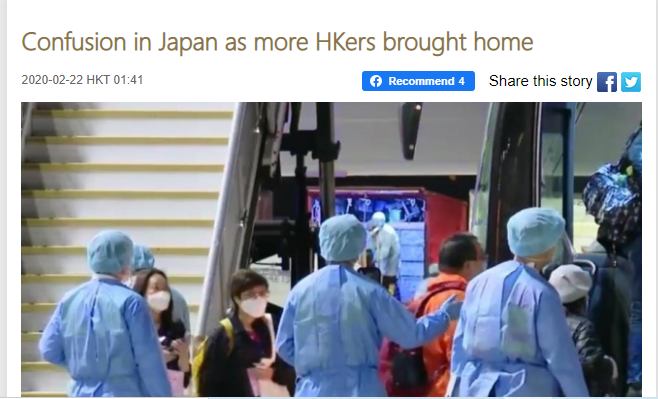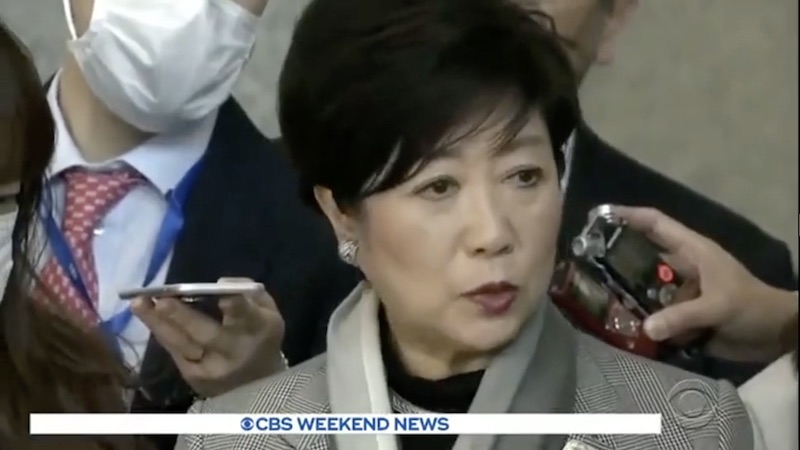
Chinese (Hong Kong) media reported that Hong Kong passengers heading for Haneda to return home in a charter flight included passengers who had close contacts with infected people. They, furthermore, say Japan was at fault for this. If true, this can not be left unheeded.
Claim
The Japanese government suddenly withdrew permission for 29 people on board the cruise ship “the Diamond Princess” to leave the ship, claiming they had been in close contact with infected people. Though part of that group had already left the ship and arrived at Haneda Airport to take their charter flight home, 18 people were ultimately prevented from boarding their flight.
In that process, the flight was delayed for several hours. It finally left for Hong Kong with 84 people on board but without the barred passengers. According to the Chinese embassy consul who had been accompanying the passengers, the Japanese government took responsibility for the mistake and offered hotel accommodation to the affected passengers. However, the 18 people left behind instead took another flight back to Hong Kong.
a February 22 report by RTHK, Hong Kong’s public broadcaster
Verification
According to the Ministry of Health, Labour and Welfare, the Hong Kong government had arranged three charter flights for passengers of the Diamond Princess cruise ship. These flights departed Haneda airport on Feb 20, 21, and 23 with a total of 195 people headed for Hong Kong.
The conditions for being allowed on these charter flights differed by nation, however in Hong Kong’ case passengers were allowed if they tested negative for Covid-19 test and had not been in close contact with infected people.
The flight involved in the incident reported by Chinese media was the second charter flight. RTHK, Hong Kong’s public broadcast service, reported on Feb 22 the following:
According to a February 22 report by RTHK, Hong Kong’s public broadcaster, the Japanese government suddenly withdrew permission for 29 people on board the cruise ship “the Diamond Princess” to leave the ship, claiming they had been in close contact with infected people. Though part of that group had already left the ship and arrived at Haneda Airport to take their charter flight home, 18 people were ultimately prevented from boarding their flight.
In that process, the flight was delayed for several hours. It finally left for Hong Kong with 84 people on board but without the barred passengers. According to the Chinese embassy consul who had been accompanying the passengers, the Japanese government took responsibility for the mistake and offered hotel accommodation to the affected passengers. However, the 18 people left behind instead took another flight back to Hong Kong.
CCTV, China Central Television – the mainland Chinese national broadcaster – also reported around the same time the following:
Only passengers of the Diamond Princess Cruise ship who had taken Covid-19 tests by Feb 19 and were not only negative but also had not been in close contact with other infected people onboard were going to be allowed to leave the cruise ship.
However, Japan mistakenly allowed 28 Hong Kong residents who had been in close contact with infected people to disembark. Of those residents, 19 had already arrived in Haneda by coach, and were proceeding with boarding procedures.
These passengers were asked to return to the cruise ship, and other passengers also had returned to the port after this issue came to light, according to CCTV.
While both reports used slightly different numbers (of passengers), both reports noted that Hong Kong residents suspected to have been in close contact with infected people had spent time in Haneda Airport.
The Health, Labor and Welfare Ministry’s denial
Is it even true that Hong Kong residents who were suspected to be in close contact with infected people spend time in Haneda Airport? We asked the Health, Labor and Welfare Ministry’s Novel Coronavirus Task Force Headquarters about this.
First of all, the task force denied these reports, before explaining what happened that day.
“People authorised to board charter flights were those who had not only tested negative for Covit-19 but also had not been in close contact with infected people,” a member of the task force explained.
“They were issued disembarkation permits by the quarantine station on the ship. Only people issued those permits disembarked, then immediately took a bus that had been provided for them headed for Haneda airport”
However, there were a few incidents that may have caused some confusion, which the task force proceeded to explain.
“Two passengers who had been in close contact with infected people did indeed get on the bus for the second charter flight mentioned in the news reports.
However, when the bus arrived at Haneda Airport, they did not go inside the airport but instead were moved to facilities in Wako city where they stayed for further observations,” the task force said.
This facility in Wako city is part of the campus of the National Tax College which is currently being used as an isolation facility for people suspected of having been infected. The task force insisted that at no point did these two people enter Haneda airport.
Furthermore, they said, both wore masks in the bus and were seated at a sufficient distance from other passengers.
“There is no evidence that these two spent time inside Haneda airport,” the task force said.
However, that was not the only incident. The other incident involved the other 102 people, now excluding the 2 aforementioned, who arrived at Haneda Airport for the second charter flight.
It is true that 18 people were not able to board their charter flight
“These 18 people did not have on them their disembarkation permits. We are still confirming this, but these 18 people had permission to disembark. And they had all tested negative and had not engaged with other infected passengers. So, they should have been able to board their charter flight to return home.”
However, Cathay Pacific Airlines, which was operating this charter flight at that time, refused to allow the 18 to board, which added to the confusion.
“We had to find other ways to deal with the 18 passengers the airline had refused to allow to board because they did not have their disembarkation permits on them.”
That is why, as RTHK reported, 84 people left Japan on this charter flight and another 18 people returned to Hong Kong on another airline flight the same day.
While the task force officials said it was not clear why those 18 people did not have their disembarkation permits on them, “It was not true that people who had close contact with infected people spent time in Haneda as reported by Chinese media”
The officials also insisted that “it was not true” that the fault lay with Japanese officials.
Conclusion
Rating Suspended
The Health, Labor and Welfare Ministry’s task force officials responded to our interviews several times between March 4 and 18, and many of their explanations were very detailed. Thus, we believe it is unlikely they would have strayed from the facts.
However, we also believe that it would be very difficult to confirm the veracity of all the detailed explanations that were offered by the Health, Labor and Welfare Ministry’s task force of officials.
Thus, we have issued this a “rating suspended” fact-check rating as we can’t confirm or deny the facts each side offers.
We would like to re-examine the facts again once Japanese government offers a clear explanation or offers to correct them.
This fact check was supported by Associate Professor Masato Kajimoto of Hong Kong University.
(Yoichiro Tateiwa)


